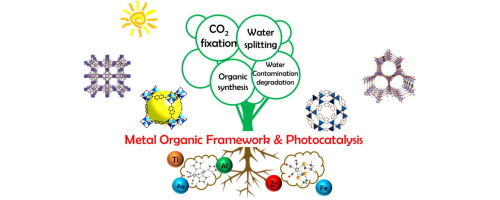Coordination Chemistry Reviews ( IF 20.3 ) Pub Date : 2017-09-28 , DOI: 10.1016/j.ccr.2017.09.013 Yuanxing Fang , Yiwen Ma , Meifang Zheng , Pengju Yang , Abdullah M. Asiri , Xinchen Wang

|
Metal organic frameworks (MOFs) have received increasing attention in the field of photoredox catalysis, mainly due to the advantages of the highly porous nanostructure and tunable semiconducting properties. Thus, the essential roles of photocatalysis by MOF can be conventionally optimized toward addressing the environment and energy issues. In this review, the fundamental of the photocatalytic MOF is initially discussed. A range of the solar-driven applications by photocatalytic MOF are highlighted, including water contamination degradation, water splitting, CO2 reduction and organosynthesis. In each chapter, a series of systematic investigations is presented, also involving a few recent results and unique phenomena that bestowed by the photocatalytic MOFs. The future prospects and challenges to use MOFs for each photocatalysis application are proposed.
中文翻译:

通过光氧化还原催化转化太阳能的金属有机框架
金属有机骨架(MOF)在光氧化还原催化领域受到越来越多的关注,这主要归因于高度多孔的纳米结构和可调节的半导体特性的优点。因此,可以通过传统方式优化通过MOF进行光催化的基本作用,以解决环境和能源问题。在这篇综述中,首先讨论了光催化MOF的基本原理。着重介绍了光催化MOF在太阳能驱动下的一系列应用,包括水污染物降解,水分解,CO 2还原和有机合成。在每一章中,介绍了一系列系统的研究,还涉及光催化MOF带来的一些最新结果和独特现象。提出了在每种光催化应用中使用MOF的未来前景和挑战。











































 京公网安备 11010802027423号
京公网安备 11010802027423号